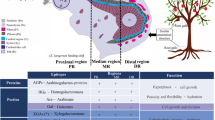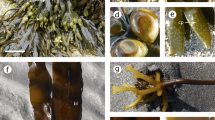Summary
A detailed histochemical investigation was carried out on rind, cortical and medullary hyphae of sclerotia ofSclerotinia minor Jagger. Four developmental stages, including mature sclerotia, were studied. The walls and septa of all hyphae contained chitin and β-1,3 glucans, while those of the rind contained in addition, a melanin-like pigment. An extracellular matrix, which accumulated around cortical and medullary hyphae, consisted primarily of β-1,3 glucans, although another polysaccharide, which could not be identified by histochemical methods, was also present. Phenolic material was deposited around the extracellular matrix and in the few interhyphal spaces that remained at maturity. Glycogen was present throughout the cytoplasm of hyphae of the cortex and medulla, at all stages of their differentiation. Polyphosphate granules were laid down within small vacuoles and as sclerotia matured, became most common in the cortical region. Protein bodies developed rapidly in cortical and medullary hyphae until at maturity, they were the most obvious interhyphal feature. These bodies were either round or elongated in shape, the elongated ones often lying parallel to the long axis of the hyphae, and in close association with strands of endoplasmic reticulum. No lipid reserves were detected.
Similar content being viewed by others
References
Ashford, A. E., Ling Lee, M., Chilvers, G. A., 1975: Polyphosphate in eucalypt mycorrhizas: a cytochemical demonstration. New Phytol.74, 447–453.
Bancroft, J. D., 1976: Histochemical techniques. 2nd ed. London and Boston: Butterworths.
Bartnicki-Garcia, S., 1968: Cell wall chemistry, morphogenesis, and taxonomy of fungi. A. Rev. Microbiol.22, 87–108.
Bennett, J., Scott, K. J., 1971: Inorganic polyphosphates in the wheat stem rust fungus and in rust-infected wheat leaves. Physiol. Plant Pathol.1, 185–198.
Bracker, C. E., 1967: Ultrastructure of fungi. Ann. Rev. Phytopathol.5, 343–374.
Bullock, S., Willetts, H. J., Ashford, A. E., 1980: The structure and histochemistry of sclerotia ofSclerotinia minor Jagger I. Light and electron microscope studies on sclerotial development. Protoplasma104, 315–331.
Burstone, M. S., 1955: An evaluation of histochemical methods for protein groups. J. Histochem. Cytochem.3, 32–49.
Calonge, F. D., 1970: Notes on the ultrastructure of the microconidium and stroma inSclerotinia sclerotiorum. Arch. Mikrobiol.71, 191–195.
Chet, I., Henis, Y., 1968: X-ray analysis of hyphal and sclerotial walls ofSclerotium rolfsii Sacc. Can. J. Microbiol.14, 815–816.
— —,Mitchell, R., 1967: Chemical composition of hyphal and sclerotial walls ofSclerotium rolfsii Sacc. Can. J. Microbiol.13, 137–141.
—,Timar, D., Henis, Y., 1977: Physiological and ultrastructural changes occurring during germination of sclerotia ofSclerotium rolfsii. Can. J. Bot.55, 1137–1142.
Coley-Smith, J. R., Cooke, R. C., 1971: Survival and germination of fungal sclerotia. Ann. Rev. Phytopathol.9, 65–92.
Cooke, R. C., 1969: Changes in soluble carbohydrates during sclerotium formation bySclerotinia sclerotiorum andS. trifoliorum. Trans. Br. mycol. Soc.53, 77–86.
Farrar, J. F., 1976: The uptake and metabolism of phosphate by the lichenHypogymnia physodes. New Phytol.77, 127–134.
Fawcett, D. W., 1958: The identification of paniculate glycogen and ribonucleoprotein granules in electron micrographs. J. Histochem. Cytochem.6, 95–96.
Feder, N., O'Brien, T. P., 1968: Plant microtechnique: some principles and new methods. Am. J. Bot.55, 123–142.
Fisher, D. B., 1968: Protein staining of ribboned epon sections for light microscopy. Histochemie16, 92–96.
Gunning, B. E. S., Steer, M. W., 1975: Ultrastructure and the biology of plant cells. London: Edward Arnold.
Harborne, J. B., Mabry, T. J., Mabry, H., 1975: The flavonoids. London: Chapman & Hall Ltd.
Harold, F. M., 1966: Inorganic polyphosphates in biology: structure, metabolism, and function. Bacteriol. Rev.30, 772–794.
Hawker, L. E., 1965: Fine structure of fungi as revealed by electron microscopy. Biol. Rev.40, 52–92.
Hughes, J., McCully, M. E., 1975: The use of an optical brightener in the study of plant structure. Stain Technol.50, 319–329.
Jensen, W. A., 1962: Botanical histochemistry. San Francisco and London: W. H. Freeman and Co.
Jones, D., 1970: Ultrastructure and composition of the cell walls ofSclerotinia sclerotiorum. Trans. Br. mycol. Soc.54, 351–360.
Jorgensen, L. B., Beinke, H. D., Mabry, T. J., 1977: Protein-accumulating cells and dilated cisternae of the endoplasmic reticulum in three glucosinolate-containing genera:Armaracia, Capparis, Drypetes. Planta137, 215–224.
Kybal, J., 1964: Changes in N and P content during growth of ergot sclerotia due to nutrition supplied by rye. Phytopathology54, 244–245.
Le Tourneau, D., 1966: Trehalose and acyclic polyols in sclerotia ofSclerotinia sclerotiorum. Mycologia58, 934–942.
—, 1979: Morphology, cytology, and physiology ofSclerotinia species in culture. Phytopathology69, 887–890.
Lev, R., Spicer, S. S., 1964: Specific staining of sulphate groups with alcian blue at low pH. J. Histochem. Cytochem.12, 309.
Ling-Lee, M., Cilvers, G. A., Ashford, A. E., 1977: A histochemical study of phenolic materials in mycorrhizal and uninfected roots ofEucalyptus fastigata Deane and Maiden. New Phytol.78, 313–328.
Mace, M. E., 1963: Histochemical localization of phenols in healthy and diseased banana roots. Physiologia Pl.16, 915–925.
Massaro, E. J., Markert, C. L., 1968: Protein staining on starch gels. J. Histochem. Cytochem.16, 380–382.
Nair, N. G., White, N. H., Griffin, D. M., Blair, S., 1969: Fine structure and electron cytochemical studies ofSclerotium rolfsii Sacc. Aust. J. biol. Sci.22, 639–652.
Nishi, A., 1961: Role of polyphosphate and phospholipid in germinating spores ofAspergillus niger. J. Bacteriol.81, 10–19.
O'Brien, T. P., Feder, N., McCully, M. E., 1964: Polychromatic staining of plant cell walls by toluidine blue O. Protoplasma59, 368–373.
Pearse, A. G. E., 1968: Histochemistry. Theoretical and applied. Vol. I, 3rd ed. London: J. and A. Churchill Ltd.
Ramalingam, K., Ravindranath, M. H., 1970: Histochemical significance of green metachromasia to toluidine blue. Histochemie24, 322–327.
Revel, J. P., Napolitano, L., Fawcett, D. W., 1960: Identification of glycogen in electron micrographs of thin tissue sections. J. biophys. biochem. Cytol.8, 575–589.
Saito, I., 1974 a: Utilization of β-glucans in germinating sclerotia ofSclerotinia sclerotiorum (Lib.) de Bary. Ann. phytopath. Soc. Japan40, 372–374.
—, 1974 b: Ultrastructural aspects of the maturation of sclerotia ofSclerotinia sclerotiorum (Lib.) de Bary. Trans. mycol. Soc. Japan15, 384–400.
—, 1977: Studies on the maturation and germination of sclerotia ofSclerotinia sclerotiorum (Lib.) de Bary, a causal fungus of bean stem rot. Rep. Hokkaido Prefect. Agric. Expt. Sta.26, 1–106.
Smith, M. M., McCully, M. E., 1978: A critical evaluation of the specificity of aniline blue induced fluorescence. Protoplasma95, 229–254.
Wang, S. Y. C., Le Tourneau, D., 1971: Carbon sources, growth, sclerotium formation and carbohydrate composition ofSclerotinia sclerotiorum. Arch. Mikrobiol.80, 219–233.
Waters, H., Moore, D., Butler, R. D., 1975: Morphogenesis of aerial sclerotia ofCoprinus lagopus. New Phytol.74, 207–213.
Weete, J. D., Weber, D. J., Le Tourneau, D., 1970: Hydrocarbons, free fatty acids, and amino acids of sclerotia ofSclerotinia sclerotiorum. Arch. Mikrobiol.75, 59–66.
Willetts, H. J., 1971: The survival of fungal sclerotia under adverse environmental conditions. Biol. Rev.46, 387–407.
Author information
Authors and Affiliations
Additional information
Mrs. S.Lowry.
Rights and permissions
About this article
Cite this article
Bullock, S., Ashford, A.E. & Willetts, H.J. The structure and histochemistry of sclerotia ofSclerotinia minor Jagger. Protoplasma 104, 333–351 (1980). https://doi.org/10.1007/BF01279777
Received:
Accepted:
Issue Date:
DOI: https://doi.org/10.1007/BF01279777




